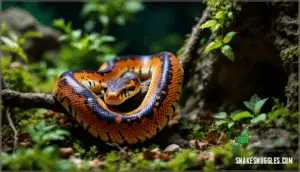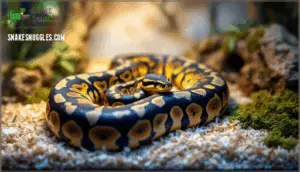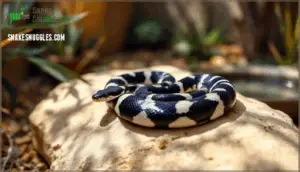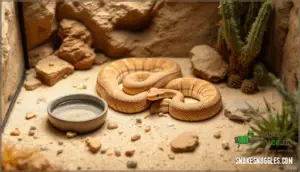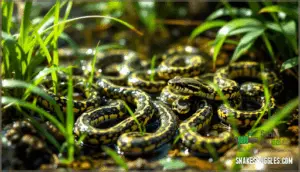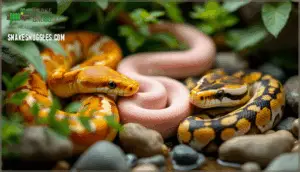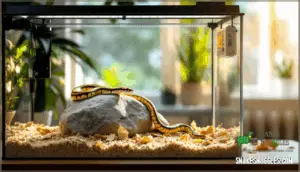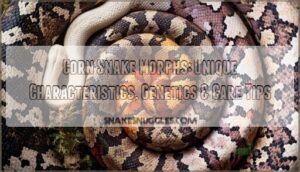This site is supported by our readers. We may earn a commission, at no cost to you, if you purchase through links.
 Most people picture snakes as slippery escape artists or wild jungle dwellers, but some breeds would rather curl up quietly in your palm than slither off in a panic.
Most people picture snakes as slippery escape artists or wild jungle dwellers, but some breeds would rather curl up quietly in your palm than slither off in a panic.
The gentle pet snake breeds is full of surprises—think soft scales, calm movements, and a knack for making even first-time owners feel at ease. These snakes don’t bite out of fear, don’t fuss when picked up, and often greet you with a slow flick of the tongue.
If you’re hoping for a pet that’s low-maintenance and soothing, you’ll find plenty of friendly options waiting to win you over.
Table Of Contents
Key Takeaways
- Gentle pet snake breeds like corn snakes and ball pythons are calm, easy to handle, and rarely bite, making them perfect for beginners.
- Choosing captive-bred snakes helps ensure predictable temperament, better health, and easier adaptation to home life.
- Setting up a proper enclosure with the right temperature, humidity, and hiding spots is key to keeping your snake happy and stress-free.
- Regular, gentle interaction builds trust and makes these snakes safe companions for both adults and children.
What Makes a Snake Breed Gentle?
Not all snakes are created equal in terms of temperament. Some species naturally show calm and predictable actions that makes them perfect for first-time owners.
Understanding what separates a gentle snake from a defensive one helps you pick the right companion for your home.
Defining Gentle Temperament in Snakes
A gentle snake temperament starts with docility indicators you can observe and measure. When you pick up a snake, its stress response tells you everything. Does it stay calm or thrash around? Corn snakes and ball pythons show minimal stress during pickup. They tolerate human interaction without defensive strikes.
Captive demeanor matters too. Snakes bred in captivity adapt better than wild-caught ones. Welfare considerations include consistent snake demeanor across multiple pickup times. Recent studies suggest that social buffering can reduce stress in snakes.
Key Traits of Friendly Snake Species
Friendly snakes share specific snake characteristics and actions you can spot early. Look for these traits when choosing your first pet:
- Docile temperament during interaction – Ball pythons tolerate over an hour of interaction without stress. Corn snakes adapt within weeks to regular pickup sessions.
- Manageable size patterns – Most friendly snakes reach 3–6 feet. That’s perfect for beginners.
- Action adaptability – Captive breeding programs create snakes comfortable with human contact. Ball pythons have over 3,000 morphs bred specifically for calm actions.
These snakes are often ideal for beginners due to their calm nature. Capacity to be held improves across generations when breeders select for gentleness.
Benefits of Choosing Gentle Snakes as Pets
Once you understand what makes these snakes friendly, the real question becomes: why should you pick one of these calm breeds over a more temperamental species?
Beginner-friendly snake species offer low-maintenance care and reduce bite risk dramatically. Their docile temperament means safer interaction for kids and therapeutic value for anxiety relief.
Beginner-friendly snake breeds offer low-maintenance care, safer handling for kids, and a calming presence for anxious owners
Friendly snakes become educational pets that teach responsibility while providing unique companionship unlike traditional pets.
Top Gentle Pet Snake Breeds
Now let’s explore the eight gentle snake breeds that make perfect companions for first-time owners. Each species brings something unique to the table regarding size, coloration, and care requirements.
You’ll find options ranging from the classic corn snake to the tiny ringneck snake.
Corn Snakes
Corn snakes rank as the most popular beginner-friendly snake species for good reason. These docile snakes generally grow between 4–6 feet and display curious yet gentle temperaments.
You’ll find captive-bred Cornsnake Morphs in dozens of stunning color patterns. Their enclosure enrichment needs stay simple—a 20–40 gallon tank with proper heating works great.
Feeding habits prove straightforward with frozen-thawed mice. Interaction requires minimal effort since these pet snakes tolerate regular interaction once they settle in.
Ball Pythons
Ball pythons earn their reputation as one of the most beginner-friendly snake species. You can choose from over 500 morph variations in striking colors and patterns.
These docile snakes reach about 5 feet and show calm temperaments that make restraint a breeze. Their feeding habits stay predictable with frozen-thawed prey.
Enclosure enrichment needs remain simple with proper heat and humidity around 50–60%. Ball pythons tolerate regular interaction well and rarely show aggression.
California Kingsnakes
California Kingsnakes measure 3–5 feet and offer a calm temperament that’s perfect for homes with kids. These beginner-friendly snake species show adaptable feeding habits and tolerate being held well once you establish consistent routines.
Their nonvenomous nature and temperament shifts from defensive to docile make them excellent choices. You’ll need strong enclosure security though—their escape artistry is legendary.
With proper snake pet care requirements met, their beginner suitability shines through steady socialization.
Rosy Boas
Rosy boas grow 6–9 feet and exhibit a docile temperament that makes them standout beginner-friendly snake species. These pet snakes tolerate cooler climates and thrive when you source captive breeding stock—wild-caught individuals show unpredictable temperament variations.
Their natural habitat spans desert regions, yet morph availability has expanded thanks to responsible conservation status management. You’ll appreciate their calm interaction response once socialized.
Hognose Snakes
Hognose snakes average 25–30 inches and showcase curiosity without aggression—even their defensive displays involve bluffing rather than biting. These beginner-friendly snake species thrive with proper captive care and offer stunning morph variations that appeal to enthusiasts.
Your husbandry tips checklist:
- Maintain sandy substrate mimicking natural habitats
- Keep humidity low to prevent respiratory issues
- Provide enclosure enrichment with burrow opportunities
- Source captive-bred individuals for docile temperament
- Monitor conservation status to support ethical breeding
Their nonvenomous nature and manageable size make them ideal starter pets.
Garter Snakes
Garter snakes display consistent social conduct and reach small to medium sizes with distinctive longitudinal stripes. These nonvenomous snakes accept diet variety beyond frozen rodents—making them beginner-friendly snake species for households seeking low-maintenance snake care.
You’ll appreciate their adaptable nature as snake species as pets. Provide enclosure enrichment with hiding spots and explore stunning garter morphs available through captive breeding programs.
Rough Green Snakes
Rough green snakes bring diurnal activity and arboreal habitat preferences to your snake collection. These slender, nonvenomous snakes feature bright green coloration, perfect for camouflage among foliage. Their insectivore diet differs from typical rodent-feeding snake species as pets—requiring crickets and soft-bodied prey.
Beginner friendliness depends on your commitment to specialized care:
- Arboreal habitat setup with climbing branches and live plants
- Diurnal activity patterns allowing daytime observation
- Insectivore diet maintenance with vitamin-dusted crickets
- Delicate body requiring minimal interaction
- Stress-sensitive snake disposition and temperament needing quiet environments
Beginner-friendly snake species exist elsewhere if you prefer hands-on interaction.
Ringneck Snakes
Ringneck snakes measure just eight to fifteen inches long and feature a distinctive yellowish-orange belly that contrasts with dark gray or black top coloring. These tiny, nonvenomous snakes stay secretive and prefer underground burrows in the wild. Your interaction should remain minimal, as their small size and stress-sensitive nature make them poor beginner pets. Captive care demands specialized setups with moist substrate and tiny invertebrate prey items.
| Characteristic | Description | Beginner Suitability |
|---|---|---|
| Size | 8-15 inches | Delicate for interaction |
| Habitat needs | Moist substrate, hiding spots | Moderate maintenance |
| Diet | Small invertebrates, earthworms | Specialized feeding |
| Temperament | Secretive, stress-prone | Not ideal for interaction |
Color variations include bright orange neck rings in some populations. Better beginner-friendly snake species exist if you want regular interaction with your snake care routine.
Key Characteristics of Gentle Snake Species
When you’re choosing a gentle snake, you need to know what makes these species so beginner-friendly.
Each breed has distinct physical traits and behavioral tendencies that affect how easy they’re to care for. Let’s look at the key characteristics that set gentle snakes apart from their more temperamental cousins.
Size and Appearance
Gentle snakes come in all sorts of sizes and looks, from tiny ringnecks that fit in your palm to striking carpet pythons that stretch longer than most adults. Body length ranges from 10 inches to 12 feet.
Color variations and pattern diversity make snake species characteristics incredibly exciting. Unique markings and color morphs give each snake appearance its own special personality.
You’ll find snake pets with smooth scale texture or keeled scales.
Handling Tolerance
Once you know what a snake looks like, the next step is figuring out how much it actually enjoys being picked up and held. Frequency of interaction matters because gentle snake pets like corn snakes and ball pythons tolerate regular interaction without stress signs. Bite risk stays low when you recognize temperament changes early.
- Corn snakes adapt quickly to snake interaction with minimal stress
- Ball pythons curl defensively instead of biting when nervous
- California kingsnakes need consistent early interaction for best results
- Hognose snakes show curiosity but rarely act aggressively
- Child safety improves dramatically with predictable, captive-bred specimens
Understanding snake actions and temperament helps you provide better snake care and interaction throughout their lives.
Typical Behavior Patterns
Beyond care, you need to recognize typical snake actions throughout the day. Relaxed breathing and regular eating patterns signal contentment in most gentle species. Defensive displays include hissing or coiling into an "S" shape. Ball pythons curl into tight balls when stressed. Kenyan sand boas show burrowing tendencies most of the time. Garter snakes demonstrate more social activity than other breeds. Basking habits vary by species but indicate healthy thermoregulation.
Understanding snake activity and temperament improves your snake care skills dramatically.
Lifespan and Growth Rate
Most gentle snakes hit their adult size between two and five years, but their total lifespan can surprise first-time owners who expect a short commitment. Corn snakes live 15–20 years with proper care, while ball pythons can reach 25–30 years in captivity.
Growth rate factors include feeding frequency and temperature consistency. California kingsnakes mature faster than rosy boas, which show slower size variation throughout their maturity timeline, requiring long-term care planning for any beginner-friendly snake species.
Essential Care for Gentle Pet Snakes
Getting your gentle snake settled in starts with the right setup. You’ll need to nail down a few basics like enclosure size, temperature zones, and feeding schedules.
Here’s what every beginner snake keeper should know to keep their pet healthy and comfortable.
Ideal Enclosure Setup
Your snake’s home is like a studio apartment — every square inch matters for comfort and safety. Here’s what you need to nail your enclosure setup:
- Enclosure size: Adults need 20–40 gallon terrariums depending on species
- Substrate types: Aspen shavings or reptile carpet work great
- Thermal gradient: Create warm and cool zones for thermoregulation
- Hiding spots: Add at least two hides for security
- Enrichment items: Include branches or rocks for exploration
A proper snake habitat keeps your pet healthy and stress-free.
Temperature and Humidity Requirements
Think of temperature and humidity as your snake’s personal weather forecast — getting it wrong can lead to shedding problems or even respiratory infections.
You’ll need a thermal gradient with warm zones around 85–90°F and cool zones at 75–80°F. Humidity levels vary by species — ball pythons need 50–60% while corn snakes tolerate 40–50%.
Use monitoring equipment like digital thermometers and hygrometers. Make seasonal adjustments during winter when indoor heating drops humidity.
Feeding and Diet Considerations
All snakes are carnivores, so you’ll be feeding your pet frozen-thawed rodents like mice or rats — don’t worry, it sounds scarier than it actually is. Most gentle snake breeds accept a frozen vs. live diet easily, which is safer for both you and your pet.
Prey size should match the widest part of your snake’s body. Feeding frequency depends on age — juveniles eat weekly while adults eat every 10–14 days.
Safe Handling and Socialization Tips
Interacting with a snake isn’t like petting a dog — it takes patience and the right technique to build trust with your scaly friend. Start with gradual introduction sessions of 5–10 minutes once your snake settles into its new home.
Use a proper grip by supporting the body in multiple places rather than grabbing near the head. Reading cues like hissing or tensing helps you avoid stressing your pet.
Always supervise child interaction closely during snake interaction.
Health and Maintenance Practices
Keeping a snake healthy isn’t rocket science — stick to a solid routine and you’ll catch problems early. Spot-clean daily by removing waste and shed skin fragments to maintain enclosure hygiene. Deep-clean every week with hot soapy water and reptile-safe disinfectant while replacing substrate every 3–4 months for proper substrate management.
Monitor temperature and humidity daily using digital thermometers and hygrometers to ensure your snake’s comfort. Feed frozen-thawed prey every 7–14 days following proper feeding hygiene protocols.
Schedule vet checkups every 6–12 months for health monitoring since snakes hide illness well.
Tips for Choosing and Purchasing Gentle Snakes
Getting your first gentle snake is exciting, but you need to know where to look and what to watch for. Finding a healthy, calm snake from the right source makes all the difference in your experience as a new owner.
Let’s walk through the key steps to help you bring home the perfect gentle companion.
Finding Reputable Breeders
Finding a reputable breeder is a bit like picking the best apple at the market—you want quality, not surprises. Ethical breeding matters, so check breeder credentials and legal compliance.
Online marketplaces like Elite Auctions offer transparency, while local expos let you meet breeders face-to-face. Always ask about captive-bred snakes; they’re healthier and easier for new snake owners.
Assessing Snake Temperament Before Purchase
Once you’ve found a trustworthy breeder, it’s smart to spend a little time getting to know the snake’s personality before making it part of your family. Here’s what to check:
- Interaction experience
- Breeder reputation
- Observing conduct
- Health indicators
- Temperament signs
Watch for calm, curious movements—these reveal gentle snake characteristics and conduct.
Captive-Bred Vs. Wild-Caught Considerations
Captive-bred snakes usually adapt better, show steadier temperaments, and boast stronger health—think of them as the “easy mode” for choosing snake pets. Ethical sourcing matters, too, since wild-caught snakes can stress easily and impact conservation.
For beginners, picking a captive-bred snake means fewer surprises and more acclimation success. It’s a smart step in responsible snake ownership.
Preparing Your Home for a New Snake
Start with the right enclosure size—think roomy, not cramped. A secure habitat is a must, since snakes are escape artists.
Set up a thermal gradient, offer hiding spots, and pick a safe substrate. Snake care requirements also include proper humidity and temperature control.
These husbandry tips for snakes make your enclosure setup feel just right—like home.
Frequently Asked Questions (FAQs)
Can gentle snakes coexist with other pets?
It’s funny how a gentle pet snake can be both a calm companion and a potential predator. Species compatibility matters, so supervised interactions and enclosure security are key.
Hygiene concerns and predator-prey dynamics shape safe coexistence with other pets.
Are gentle snake breeds safe for children?
With proper supervision and child snake education, beginner-friendly snake species like ball pythons and children’s pythons can be safe for kids.
Teach age-appropriate care practices to lower snake bite risk and prevent zoonotic diseases.
What costs are involved in gentle snake ownership?
You’ll need to budget for the initial setup—snake enclosure, habitat equipment, and emergency funds.
Recurring expenses include snake food, bedding, and veterinary care. Feeding costs vary, but regular upkeep keeps snake pets happy and healthy.
How do gentle snakes respond to loud noises?
Imagine a snake startled by thunder—its auditory sensitivity kicks in, often causing defensive mechanisms like hiding or freezing.
Noise-induced stress can trigger shifts in conduct, and frequent loud sounds may lead to long-term effects on snake conduct and temperament.
Do gentle snakes require regular veterinary visits?
Regular vet visit frequency for snakes isn’t as high as for cats or dogs, but preventative snake care matters.
Exotic vet costs can add up, so recognizing snake illness early and following quarantine protocols helps maintain healthy pet ownership.
Conclusion
Imagine a young owner, nervous at first, finding calm with a corn snake curled gently around their wrist. That’s the magic gentle pet snake breeds can bring—confidence grows, fears fade, and curiosity blooms.
These species don’t just fit into your life; they quietly enrich it, offering silent companionship and a window into nature’s softer side.
If you’re ready to welcome a new friend, you’ll find that gentle snakes make the journey rewarding, peaceful, and full of wonder.
- https://a-z-animals.com/animals/snake/snake-facts/friendliest-snakes/
- https://www.petmd.com/reptile/popular-pet-snake-species
- https://www.xyzreptiles.com/three-friendly-snake-breeds/
- https://millerlab.ca/labsite/docs/pubs/2022_Skinner_b.pdf
- https://www.reddit.com/r/snakes/comments/1acpue8/help_whats_the_best_beginner_snake_species/

